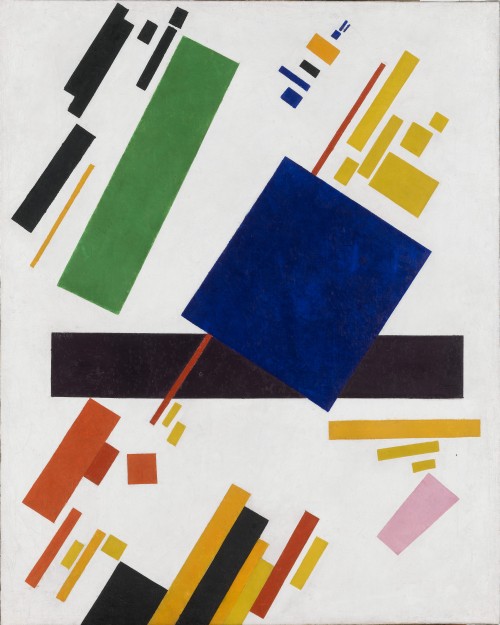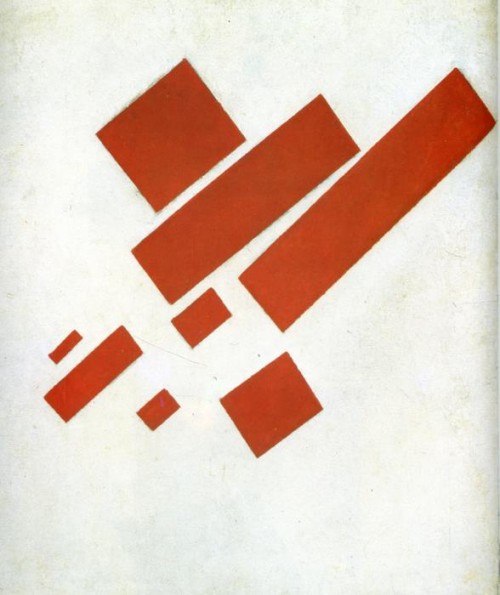
Kazimir Malevich. Suprematist composition (blue rectangle over purple beam), 1916. Oil on canvas, 34 1/2 x 27 3/4 in. Collection of the Heirs of Kazimir Malevich.
Can you reduce visual perception to a few fundamental elements? Artists and scientists have approached this question from radically different directions.
One major discovery of sensory processing happened almost entirely by accident. In the late 1950s, two neurobiologists, David Hubel and Torsten Wiesel, set up a series of experiments in the lab to study the basic building blocks of vision. What they were looking for, however, was not simply optical. They were looking to decipher how the brain received visual signals. It was clear that light excited the cells in the retina but what kind of input switches on the cells in the mind?
Let’s take a step back. It’s important to first understand that, optically, the brain does not function like a camera. It does not reflect the material world directly onto the back of the skull like a mirror. Every bit of visual input requires neural processing. We are constantly building and interpreting a reality around us. What are the first steps to actually building that reality? This is what Hubel and Wiesel wanted to study.
To experiment, they inserted a microelectrode into the visual cortex of a cat and proceeded to project various patterns of light onto the cat’s eyes. (The cat, mercifully, was paralyzed). Hubel and Wiesel were trying to find out what shapes would cause an electrical firing of individual nerve cells. They found that circles and squares and other geometric shapes had little or no effect. Not until the slides were changed did the electrode begin sensing excitement in individual cells. Something was happening in between the changing of slides that elicited reaction.
Turns out that the cat was reacting to the shadow along the edge of the transparency, which amounted to little more than a faint diagonal line. (For a visual diagram of their study, see this article in the Journal of Physiology.) Eureka. They had just unlocked something remarkable about the eye and brain.
Brain cells in the visual cortex, they discovered, respond selectively to stimuli. Known as “selective orientation” cells, the neurons they were studying responded to lines in a specific orientation, in this case, a diagonal orientation. If you think of the significance of their discovery in terms of a secret language, it was as if they had just decoded the meaning of a letter in an alphabet. And once they understood the smallest unit, they could begin deciphering the rest of the alphabet, and ultimately, words and sentences.
Hubel and Wiesel’s discovery inspired them to continue their experiments. Ultimately, their studies would demonstrate how, from simple stimuli, the visual system constructs reality around us. They dedicated the rest of their careers to peeling back the layers of visual perception.
Many decades before Hubel and Wiesel’s work, Abstract Expressionists set out to unpack the fundamental elements of the visual system. Artists like Piet Mondrian and Kazimir Malevich sought to extract the very essence of our visual language. “To create pure reality plastically,” Mondrian believed, “it is necessary to reduce natural forms to the constant elements.”
In communist Russia, Malevich set out to completely deconstruct representational painting. Passionate, strong-jawed, and wild-eyed, he attacked traditional painting and the values it was founded upon with devilish fervor. In December of 1915, Malevich debuted a gallery show of paintings in which he eschewed real world subjects; his paintings were filled with simple geometric shapes. With a slightly ominous tone, he called his school of painting Suprematism, because of its supposed supremacy over nature. Similar to Neoplasticism, both schools focused on the building blocks of visual language, favoring bold colors and geometric shapes over representational art. They were seeking purity of form. Malevich called this “simple energy.” This phrase is especially interesting when you think of what Hubel and Wiesel were measuring 50 years later: how and when a neuron fires in the brain, a phenomenon that is communicated by a tiny electrical charge. Simple energy.
Malevich thought of his paintings as a new form of “painterly realism” and, according to the Museum of Modern Art’s most recent abstract expressionism show, “understood its subject to be the basic components of painting’s language, such as color, line, and brushwork.”
Using completely different sets of tools, the artists and scientists discussed here were exploring the fundamental building blocks of the visual system. While it is tempting to make a direct correlation between experiencing abstract art and the experiments done by Hubel and Wiesel, it doesn’t really work that way. The scientists were investigating the reaction of a single nerve cell in the brain; when we look at a diagonal line in a work of art, the interaction in the brain is far more complex. And yet, at the heart of the matter, there are many motivational parallels. Mondrian said, speaking of vanguard artists, “They discover, consciously or unconsciously, the fundamental laws hidden in reality and aim at realizing them.” Both groups were studying the building blocks of visual language and how, from those building blocks, new forms might eventually be constructed. “Everything has vanished,” Malevich said, “there remains a mass of material, from which the new forms will be built.”
Malevich did not fare as well for his efforts as Hubel and Wiesel. The duo was awarded the Nobel Peace Prize in 1993. Whereas with the rise of Stalin’s regime, abstract painting fell out of favor with the government, who considered it bourgeois and corrosive to society, and so Malevich’s style of painting was banned and many of his works confiscated. He died of cancer in 1935.





Pingback: Week in Review | Art21 Blog
Pingback: Brain on the Beach: Seven Essential Sources for Art and Cognitive Science | Art21 Blog